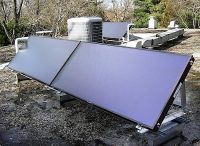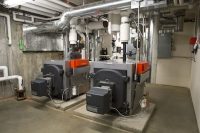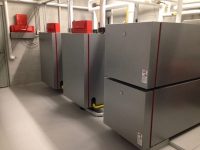The 2015 ISH Show in Frankfurt, Germany, by all accounts, did not disappoint. The show was spectacular and grandiose in size and attendance. In fact, official numbers released from the show indicate record numbers in attendance — 198,000 visitors, a new exhibitor record and a significant increase in the level of international guests. ISH Read more
Viessmann

The 2015 ISH Show in Frankfurt, Germany, by all accounts, did not disappoint. The show was spectacular and grandiose in size and attendance. In fact, official numbers released from the show indicate record numbers in attendance — 198,000 visitors, a new exhibitor record and a significant increase in the level of international guests.
ISH is the leading exhibition for sustainable sanitation solutions, innovative bathroom design and energy-efficient heating technologies in combination with renewable energies and environmentally friendly air conditioning, cooling and ventilation technology. This year, it once again brought together the sector’s most important subjects at the same time and place, and covered all horizontal and vertical aspects of future-oriented building solutions with the extensive range of products and services to be seen.
The ISH Water section was characterized by sustainable sanitation solutions for individual user requirements arising from the process of demographic change, as well as by innovative water management and drinking-water hygiene. On the Energy side, the focus was on energy efficiency as the second pillar of the new energy paradigm, i.e., the shift away from nuclear power. Modern heating, air-conditioning, cooling and ventilation technologies have a huge potential for cutting energy consumption and represent an important step on the way to achieving climate targets.
According to ISH, the claim of the being the world’s leading trade fair for the sector was substantiated by a 16% increase in the number of international visitors to 74,100—up from 63.985 in 2013) with the largest national contingents coming from Italy, France, the Netherlands, Switzerland and China. Significant growth in visitor numbers from the USA, Great Britain and Ireland are also evidence of a noticeable economic recovery in important sanitation, heating and air-conditioning markets. Altogether, there were 618 new exhibitors at ISH 2015: 161 of them from Germany, 89 from Italy and 23 from Spain, which indicates a gradual market recovery.

Aquatherm is beta testing its Aquatherm Black radiant in-wall/in-ceiling heating and cooling system — seen here at ISH — at a couple of installations in Chicago.
Yet I had heard that only 4% of total visitors were from the Unites States and finding English-speaking booth attendees proved arduous at times. Look for the Union Jack lapel and you’ve found someone that can speak the language.
If you haven’t been to ISH, there are 11 pavilions—with multiple levels—that are categorized by the bathroom experience; air conditioning, cooling and ventilation; building and energy technology/renewable energies; installation technology; home and building automation. There is plenty to see so if you plan to visit in 2017—the show takes place every other year—be sure to take as much time as you can. I attended three days at the show and wasn’t even able to see much of the show. “Overwhelming,” said Bob Short, Short’s Plumbing & Heating, Livingston, Montana. “It’s big, but in a good way.”
Additional feedback I received from the show was that the booths were large, clean, modern in appearance, and spacious enough to get around. Some of drawbacks were that a lot of the booths, again, did not have an English-speaking contingent. Also, what you see in this European trade show is, well, just that — European. A lot of the products and technology is not “transferable” to the U.S. based upon code compliance, early adoption or some products and/or technology are years down the pipeline for U.S. use.

Viega, with manufacturing facilities nearby, showed an array of products, from its water initiative program to PVF integration into plumbing systems.
Personally, the show is incredible, but its size can be daunting; wearing a comfortable pair of shoes is a must because you’ll do you good share of walking. I wish the show was a little easier to navigate but the ISH downloadable app was a plus while trying to find favorites to visit. I was issued free Wi-Fi with a press pass, but even that got a little spotty and non-existent at times.

Caleffi’s DIRTMAG magnetic dirt separator can be used to separate impurities, including ferrous ones, in the thermal medium circulating within air conditioning systems.
I was fortunate enough to spend some time—during and after the show—with gracious company hosts Aquatherm and Viega, who both have major manufacturing facilities to the north of Frankfurt, in Attendorn, Germany. I know of several other contractors who were invited by manufacturers to visit the ISH Show and to do some Germany sightseeing. This might be a great way to get an opportunity to go overseas and visit the show.
The feedback from the exhibitors was incredibly positive; you can’t deny the traffic in the booths was high. It should be noted that all visitors weren’t wearing their ISH badges, or perhaps they weren’t even issued one. It’s nice to see names on badges to do a little scouting prior to initial introductions.
Overall, the ISH Show was well worth the trip over the pond. If you can find it in your budget—time-wise and monetarily— I would highly suggest making the trek in 2017.

Riello’s residential burner, with its new digital control box, features reduced electrical consumption and highly stable and reliable low NOx combustion.

erdgas mobil’s goal is to establish compressed natural gas (CNG) and biomethane as alternative fuels of the future while developing their market potential.

STIEBEL ELTRON DHE Touch instantaneous water heater is defined by its energy efficiency: up to 30% energy and water can be saved.

Located in Bethesda, Md., the Seymour Krieger House is listed on the National Register of Historic Places, and was designed in the 1950s by internationally renowned modernist architect Marcel Breuer. The house currently is owned by an architect, and he wanted to restore the mechanical system while keeping the architectural integrity of the structure intact Read more
Located in Bethesda, Md., the Seymour Krieger House is listed on the National Register of Historic Places, and was designed in the 1950s by internationally renowned modernist architect Marcel Breuer.

A very tight mechanical room displaying a Triangle Tube Prestige boiler, Grundfos ALPHA pump, Caleffi hydro-separator and REHAU radiant tubing and manifold.
The house currently is owned by an architect, and he wanted to restore the mechanical system while keeping the architectural integrity of the structure intact. Originally heated by a radiant floor heating system, the original boiler was still in place and operational, but the wrought iron radiant piping has corroded and was leaking in multiple locations.
“We discussed multiple alternatives,” says Dan Foley, Foley Mechanical, Inc. “But in the end, the owner decided to go back with radiant floor heat.
The bluestone floor tiles were painstakingly numbered and removed. The concrete overpour, along with the original wrought iron radiant tubing, was removed.
New REHAU PEX radiant tubing system was installed, and a new concrete slab was poured. The flagstones were carefully placed back in exactly their original positions.
The entire mechanical system was updated by installing a new Triangle Tube Prestige boiler, HTP DHW tank, Viessmann solar heat and DHW system, Grundfos ALPHA pump, Caleffi hydro-separator, REHAU radiant tubing and manifold, and new Carrier high-efficiency AC system.

Four Viessmann flat panel solar collectors were mounted on the flat roof along with a Carrier 17 SEER AC unit.
To allow for multiple zones, Foley and his team re-piped and re-controlled the radiant system. The Viessmann solar system will contribute to space heat when the DHW load is satisfied.
“The clients were a joy to work for and appreciated the hard work done by my crew on this difficult and challenging project,” says Foley.

Founded by the English Benedictine community in 1926, the Portsmouth Abbey School is a coeducational, 9 – 12 academy that sits on a bucolic 500-acre campus on the shores of Narragansett Bay in Rhode Island. Dedicated to the rigors of the Western intellectual tradition, the School is also a residence for its 360 students and Read more
Founded by the English Benedictine community in 1926, the Portsmouth Abbey School is a coeducational, 9 – 12 academy that sits on a bucolic 500-acre campus on the shores of Narragansett Bay in Rhode Island. Dedicated to the rigors of the Western intellectual tradition, the School is also a residence for its 360 students and to the monks who live at its monastery. For the Abbey’s director of operations, Paul Jestings, the institution represents both an extraordinary heritage and an extraordinarily complex heating and hot water challenge: sixty buildings served by a mix of individual units and central heating plants, fueled by oil, propane, solar and soon, natural gas.

“I can’t go into the red to go green.” When Jestings first arrived at the campus as an independent contractor in 1976, he confronted an array of steam boilers that had been in service since the mid-1960s. In 1990, when he assumed full-time responsibilities at the Abbey, Jestings was charged with a mission: save energy and money through appropriate upgrades. “The steam boilers didn’t modulate; they always ran at full blast,” says Jestings. “In the winter, that means a lot of short cycling. In the summer, when all we needed was hot water, we got a lot of overkill. Either way, it’s waste.” The administration, faced with aging boilers and high fuel costs, agreed that it was time for a change — but it had to be of the right kind. “We needed something that could manage an extremely diverse load, from a heavy use of showers in the morning to almost nothing the rest of the day.” The objective: match load to demand.

But Jestings had another consideration in mind. Every significant capital purchase requires approval from the school’s board of directors. With each purchase, Jesting’s reputation and credibility is on the line. “This school can’t afford to buy equipment that lasts only eight or ten years,” he says. “We have to get at least 20 or more years from our units — and the financial numbers have to work: I can’t go into the red to go green.” He was tired of replacing boilers that failed prematurely, tired of hearing the same very first thing out of the boiler rep’s mouth, “you know the warranty has passed.” No concern of why it failed prematurely because it did what it was designed to do…last past the warranty!

Efficiency has rolled out at Portsmouth Abbey in waves, beginning almost two decades ago by replacing approximately 20 steam and hot water boilers with more efficient Viessmann hot-water boilers. By coupling the units to outdoor reset controls, the boilers modulate supply water temperature output based on outside temperatures, increasing fuel savings by 20% on top of the highest efficiencies available for oil boilers – 87% to 89%.
In the second wave, Portsmouth Abbey incorporated solar panels to provide domestic hot water (DHW). Through an enhanced hybrid design that integrates with the boiler system, the solar panels provide supplemental space heating in warmer weather; in the coldest months, the boilers offer the necessary boost for hot water.

Today, Portsmouth is anticipating access to natural gas by installing Viessmann boilers that can accommodate any gas source without requiring any burner modifications; these will run on propane until natural gas becomes available. With natural gas or propane , the condensing boilers can gain an additional 10% increase in efficiency over oil, reaching efficiencies of 97% – 98%.
Some of the retrofits have saved 20% – 25% in fuel costs; others have achieved as much as 45% improvement in fuel efficiency. “We always outperform the estimates we give to the board,” Jestings says. “We love our boilers. Our guys wax them! Who does that? It shows pride of ownership.”

Fuel efficiency, and the elimination of the need to re-invest in its equipment every eight to ten years, are not the only ways the Abbey saves money. “Back in the old days, we went through a lot of growing pains,” Jestings says. “This is a boarding school, open 365 days a year. We can’t have boilers go down. We used to do a lot of night calls — and that means wear and tear on my staff. Now my crew never comes out at night, at least not for a boiler failure. I tell the new guys, you don’t know how lucky you are!”
Low maintenance is not just a boon to Jesting’s crew; it is one of the keys to fiscal responsibility. “This stuff just doesn’t break,” says Jesting. “With Viessmann, we haven’t had a service contract in 18 years. The money we save is put towards other upgrades in the physical plant — it’s all self-funded.”
Portsmouth Abbey has become a model for other institutions struggling to control costs and achieve a greener environmental profile. Other facilities managers turn to Jestings for advice. “I tell them they have to get past that initial increase in investment. The difference between the best equipment and the rest is in the fuel savings and in the reduced service,” says Jestings. “Some people say they can’t afford to go with Viessmann. I say you can’t afford not to.”

Godbout Plumbing & Heating Inc., Biddeford, Maine, was called to the Biddeford YMCA to swap out five, eight-year-old inefficient boilers. “We pulled the five boilers in an environment they should not have been installed,” says Jim Godbout, owner. The mechanical room before the Viessmann boiler makeover. Godbout and his team installed a couple of Viessmann Read more
Godbout Plumbing & Heating Inc., Biddeford, Maine, was called to the Biddeford YMCA to swap out five, eight-year-old inefficient boilers. “We pulled the five boilers in an environment they should not have been installed,” says Jim Godbout, owner.
The mechanical room before the Viessmann boiler makeover.
Godbout and his team installed a couple of Viessmann Vitocrossal 200, CM2 condensing boilers with Viessmann HoriCells (horizontal design) for domestic hot water (DHW), and Viessmann controls. “We poured a new floor and turned a complex boiler room to simple technology,” says Godbout.
The Vitocrossal 200, CM2 condensing boiler, the latest addition to their comprehensive line of energy efficient heating solutions. The Vitocrossal 200, CM2 offers unparalleled flexibility and maximum efficiency, making it the ideal choice for a new installation or economical retrofit in large residential or commercial applications.

The Vitocrossal 200, CM2 includes a new, fully modulating Viessmann pre-mix cylinder burner with a wide modulation range of 5:1 turndown ratio to precisely match load. It operates with low inlet gas pressure (NG) of only four inches of water column for compatibility with a wide range of supply pressures and provides clean, quiet and environmentally friendly operation with outstanding thermal efficiencies up to 97%.

NOTE: The YMCA project has not been insulated as of this posting.
Godbout Plumbing & Heating Inc. is celebrating more than 25 years of business. According to Godbout, technology continues to bring them more efficient and more cost effective solutions and the team continues to stay on the cutting edge of that technology. Clients are always presented with the latest products so they can make an educated decision when it comes to systems that make their home or facility more comfortable and efficient.


















